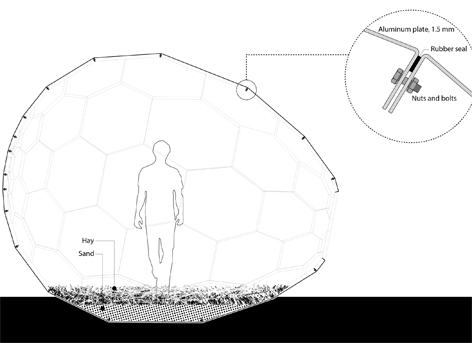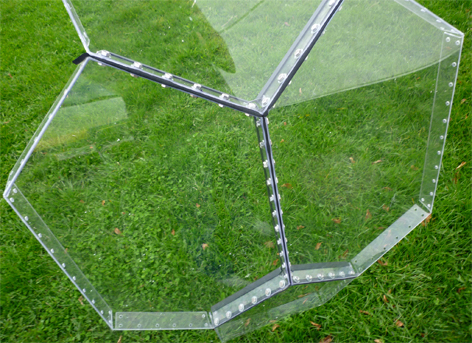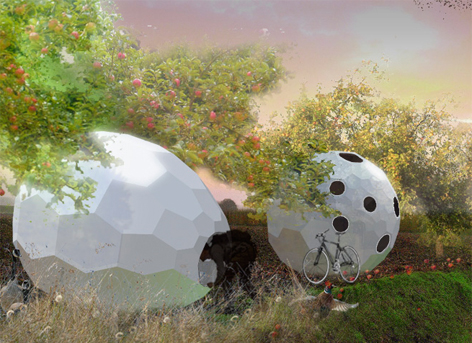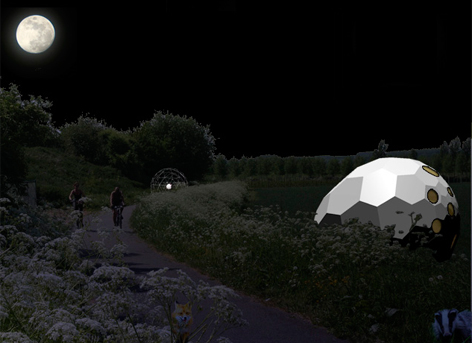SHELTERS
 Visualization of SHELTERS, 2011 |
|
Introduction:
SHELTERS is a low-cost, highly durable system that provides basic shelter for persons against rain, sun,
cold and wind. SHELTERS can be placed both in cityscapes and landscapes and can be used by any person that
needs a break from the weather conditions, needs to rest or needs a place to sleep. It could also be used as a
meeting point.
Construction:
Shelters are constructed using SPACEPLATES, a new building system developed by N55 in collaboration with Anne
Romme. SPACEPLATES is based on the geometry found in animal shells like the sea urchin. Its a low cost way of
creating approximated double curved surfaces in a statically well defined way, minimizing the material use.
lattice structures forming structures like that are very well researched and understood. Plate based
structures are not. Especially not when it comes to more freely formed, complex, tesselated shapes that are
not plain domes. The SPACEPLATES system enables persons to “ print out” a SPACEPLATES construction
(a home, a greenhouse or a larger communal building), using materials like PC or aluminum and a CNC- router.
(Even a small table version CNC- router will work). SHELTERS are build from thin weather resistant plates of
aluminum. All the plates are marked according to an assembling system and can easily be handled by one person.
The plates are cut out, folded and connected using bolts and a sealant. The form resembles the geometry of an
egg with a large entrance opening and 7 smaller window openings. Windows are made using polycarbonate plates.
The structure is positioned in a shallow excavation in the ground and a thick layer of sand is applied inside
in bottom to make it wind resistant. Finally a soft insulating material such as hay is provided as a bed.
Background:
Ownership of LAND and SHELTERS:
It is a habitual conception that ownership of land is acceptable. Most societies are characterized by the
convention of ownership. But if we claim the ownership of land, we also say that we have more right to parts
of the surface of the earth, than other persons have. We know that persons should be treated as persons and
therefore as having rights. If we say: here is a person who has rights, but this person has no right to stay
on the surfaceof the earth, it does not make sense. If one does not accept that persons have the right to stay
on the surface of the earth, it makes no sense to talk about rights at all. If we try to defend ownership of
land using language in a rational way it goes wrong. The only way of defending this ownership is by the use of
power and force. No persons have more right to land than other persons, but concentrations of power use force
to maintain the illusion of ownership of land.
The misunderstanding that persons have a right to own land leads to situations where there is no tolerance for
different ways of living and in extreme situations this leads to war.


SPACEPLATES assembly protoype in polycarbonate.
Concentrations of power limit persons’ access to land
by the force of among other things the notion of ownership. SHELTERS invites persons in and provides a
shelter. We suggest that all land should be accessible for all persons. Society could administrate rights
to use land for various functions, production of food for example, but ownership of land should be
abolished. N55 furthermore suggest that SHELTERS should be owned by all persons in common and used by the
persons wanting to use them.


Extensions:
SHELTERS could easily be equipped with various systems for cooking, generating power,
toilets and other facilities that persons use to maintain everyday life. This could encourage
persons to stay for longer periods and become part of the local environment.
Technical specifications:
Basic module:
Height: 3 meters
Width: 3 meters
Length: 4.5 meters
Weight: 100 kg
Component list:
Aluminum plates 1.5 mm
Rubber Sealant
Bolts and nuts
Sand and hay
By N55, Ion Sørvin in collaboration with Anne Romme
Thanks to:
Lene Slot Hansen and Thom Garvin
Back to manuals
Back to HOME